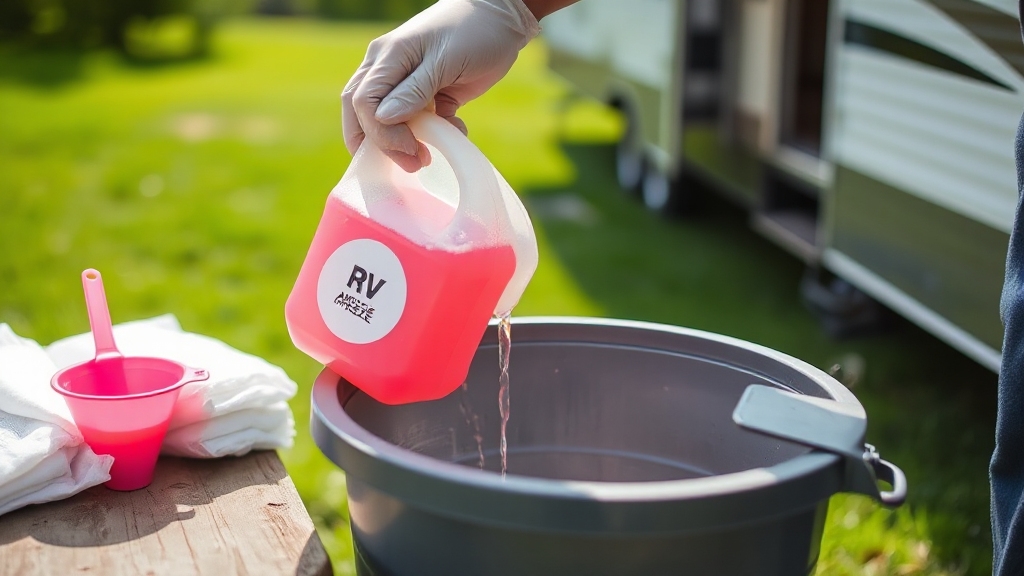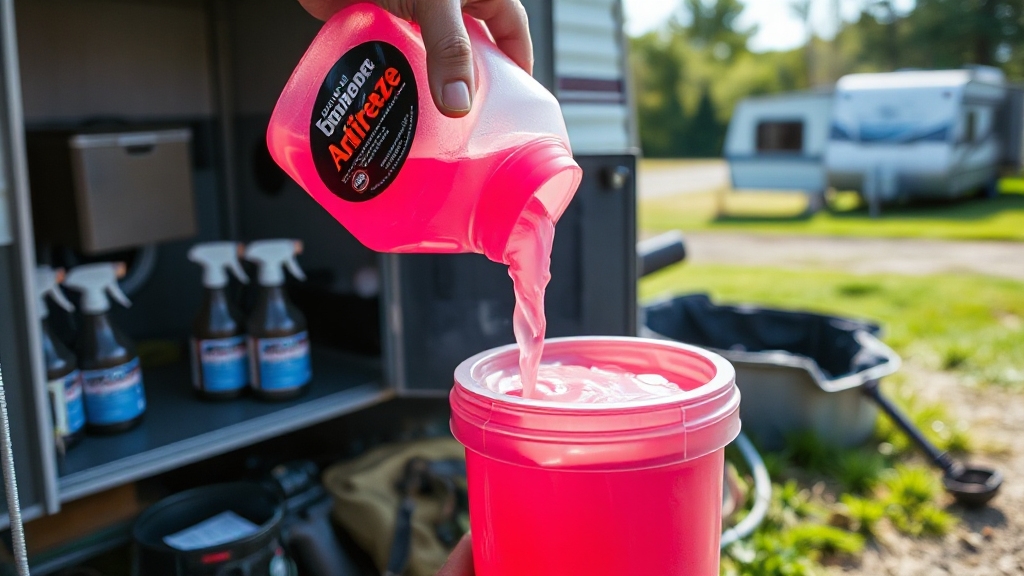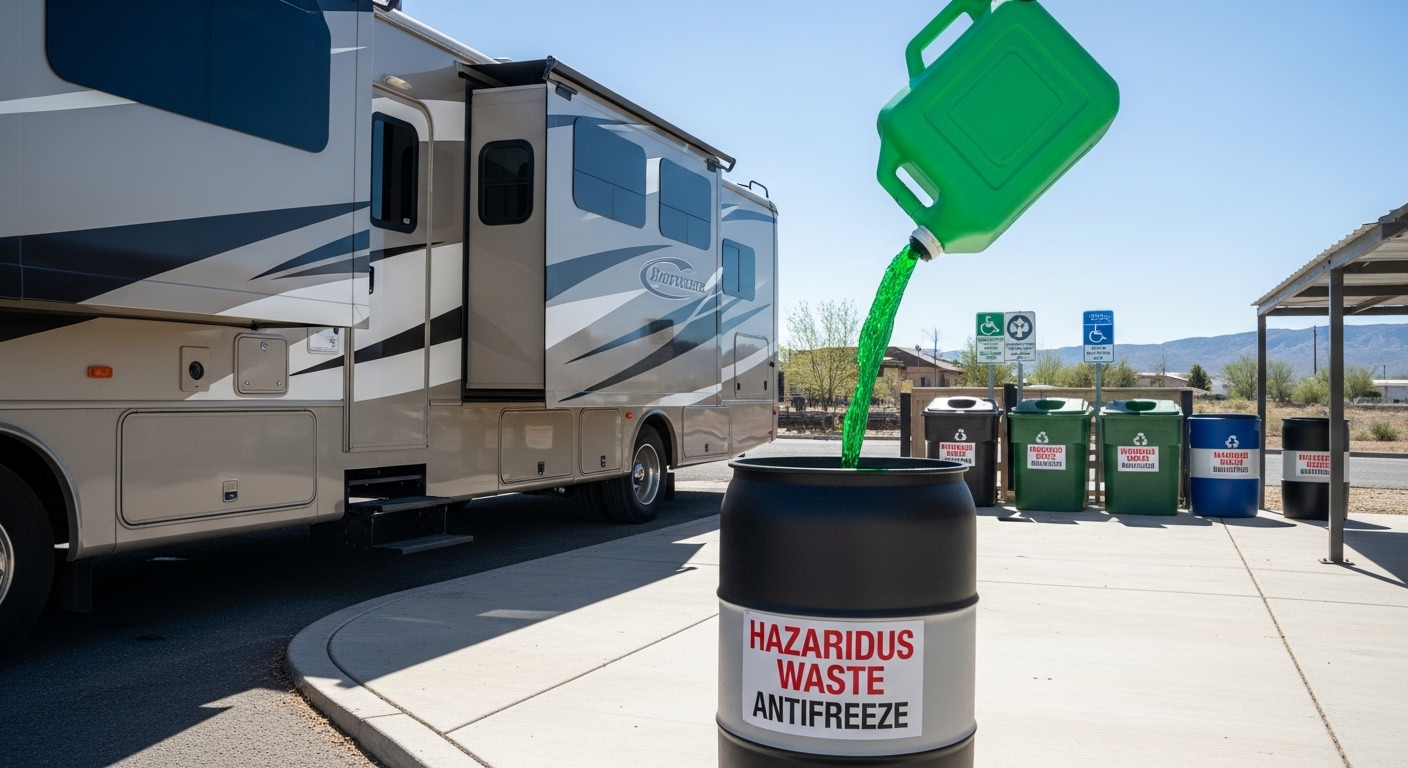To dispose of RV antifreeze safely, collect it in tightly sealed, labeled containers without mixing it with other fluids. Wear gloves and eye protection while handling it to avoid exposure. Take the antifreeze to an authorized recycling center, automotive shop, or hazardous waste facility—never pour it on soil or drains. Proper disposal prevents environmental contamination and health risks. For effective winterization and storage tips, keep following the guidelines provided here.
Key Takeaways
- Store used RV antifreeze in sealed, labeled containers to prevent spills and accidental ingestion before disposal.
- Do not pour antifreeze onto soil, storm drains, or sewer systems to avoid environmental contamination.
- Take used antifreeze to authorized recycling centers, automotive shops, or hazardous waste facilities for proper disposal.
- Avoid mixing antifreeze with other chemicals or fuels during storage and transport to disposal sites.
- Use protective gloves and eyewear when handling antifreeze and clean any spills immediately with absorbent materials.
Safe Collection and Handling of RV Antifreeze

When handling RV antifreeze, you must store it in tightly sealed, properly vented containers to prevent leaks and vapor buildup. Keep these containers away from heat sources, sparks, and open flames to reduce fire risks.
Use original or approved labeled containers to avoid accidental misuse or ingestion. It is important to handle with care because propylene glycol, the common base for RV antifreeze, can be toxic to animals.
Store antifreeze in cool, well-ventilated areas, out of children and pets’ reach. Proper storage helps maintain filtration efficiency by preventing contamination. Never mix used antifreeze with other chemicals or fuels during storage to prevent hazardous reactions.
Always wear gloves and eye protection during handling, and work outdoors or in well-ventilated spaces to avoid inhaling vapors. Clean spills immediately with absorbent materials and wash your hands thoroughly afterward.
Avoid tasting or smelling antifreeze, and keep it away from food and drink areas to minimize health hazards.
Proper Disposal Options for Used Antifreeze
Although disposing of used RV antifreeze requires careful attention to environmental regulations, you have several responsible options to guarantee safe handling. You should transport antifreeze in sealed, labeled containers and never mix it with other fluids.
Take it to authorized recycling centers, automotive shops, or hazardous waste facilities. Pure antifreeze is recyclable, while contaminated fluid must be treated as hazardous waste.
Because RV antifreeze is primarily propylene glycol and is considered non-toxic, it is safer to handle than engine antifreeze but still requires proper disposal to prevent environmental harm. Understanding the performance standards of fluids can help in identifying proper disposal methods.
| Disposal Option | Requirements | Notes |
|---|---|---|
| Automotive Repair Shops | Sealed, labeled containers | Often recycle pure antifreeze |
| Hazardous Waste Centers | Follow local quantity limits | Accept contaminated antifreeze |
| Municipal Recycling | Proper labeling, original container preferred | May hold periodic collection events |
| Auto Parts Stores | Sealed container, contamination status | Some locations accept antifreeze |
Following these methods ensures compliance and environmental safety.
Flushing RV Plumbing Systems After Winterization
Before flushing your RV plumbing system after winterization, remove or bypass water filters to prevent damage during antifreeze circulation. It is also important to drain the tanks completely to avoid any residual water freezing and causing damage. Using antifreeze specifically designed for potable water systems ensures safety and effectiveness.
Drain all tanks—fresh, grey, and black—and depressurize the water heater by draining and closing its pressure release valve. Install a water heater bypass kit to keep antifreeze out of the heater tank, ensuring all bypass valves are securely closed. This practice prevents corrosion and damage caused by inappropriate antifreeze contact with heating elements.
Attach a siphon hose to the freshwater intake, place it in pink RV antifreeze, and activate the water pump to draw antifreeze through all faucets, low-point drains, and the toilet until pink fluid appears. The use of propylene glycol-based antifreeze is preferred for its low toxicity and safety in potable water systems.
Pour antifreeze into sink drains and the toilet to protect P-traps, then flush again.
Close all valves and drains to retain antifreeze, clean spills immediately, and restore any disconnected lines for proper storage. Proper handling and disposal minimize environmental impact and prevent contamination.
Environmental and Health Precautions When Disposing Antifreeze
Since RV antifreeze contains toxic compounds like ethylene glycol, you must take strict environmental and health precautions during its disposal. Avoid pouring antifreeze onto soil, storm drains, or sewer systems to prevent groundwater contamination and harm to ecosystems.
Use protective gloves and eyewear to prevent skin irritation, and ensure proper ventilation to minimize inhalation of vapors. Promptly clean spills with absorbent materials to reduce exposure risks.
Dispose of spent antifreeze through authorized service stations, licensed recycling centers, or hazardous waste collection sites, complying with EPA regulations. Never discard tainted antifreeze as regular waste; treat it as hazardous.
Secure and label containers to prevent accidental ingestion by children or pets. Following these measures protects public health, preserves water quality, and guarantees regulatory compliance. Additionally, selecting the appropriate engine protection products can further reduce environmental impact during vehicle maintenance.
Storage and Shelf Life Considerations for RV Antifreeze

Proper handling of RV antifreeze doesn’t end with safe disposal; storing it correctly maintains its effectiveness and ensures your plumbing system stays protected. Keep antifreeze in tightly sealed containers, stored in a cool, dry place away from direct sunlight and freezing temperatures to prevent container damage.
It is important to avoid exposure to temperatures above 50℉ to maximize shelf life. Using antifreeze with a high-quality additive package can further enhance protection, similar to how engine oils maintain performance with additives.
Store RV antifreeze sealed, cool, and dry to maintain effectiveness and protect your plumbing system.
Inspect the antifreeze before use—if it has changed color or odor, replace it. Use propylene glycol-based antifreeze for safety and lubrication benefits.
Remember, antifreeze can last several years if stored properly but should be refreshed in your plumbing every two years for maximum protection.
- Protect your investment by preventing costly freeze damage.
- Maintain peace of mind with reliable winterization.
- Avoid contamination risks by labeling and sealing containers.
Follow manufacturer guidelines for storage and replacement to ensure system longevity.
Frequently Asked Questions
Can I Reuse RV Antifreeze After Winterization?
You can reuse RV antifreeze after winterization, but you need to check its concentration and contamination first. Use a refractometer to measure dilution levels and verify proper chemical balance.
Avoid reusing if it’s diluted or contaminated, as this risks freeze damage and corrosion. If you plan to reuse, collect and store it in sealed containers immediately after dewinterizing.
For safety and reliability, though, fresh antifreeze is usually the better choice.
What Are the Signs Antifreeze Has Gone Bad?
If your RV antifreeze looks cloudy, discolored, or has sediment, it’s a red flag that it’s gone bad.
When it turns slushy instead of freezing solid, or separates into layers, don’t ignore it.
You’ll also notice a loss in freeze protection or corrosion control.
Lingering taste or odor, slime buildup, or repeated need for topping up means the antifreeze has lost its edge and should be replaced promptly.
Is Propylene Glycol Antifreeze Safe for Septic Systems?
Propylene glycol antifreeze isn’t safe for septic systems. Although it’s less toxic than ethylene glycol, it doesn’t support the beneficial bacteria your septic system needs to break down waste.
Introducing it can disrupt microbial activity, potentially causing system failure or backups. You should avoid pouring it into your septic tank and opt for septic-safe, biodegradable alternatives if necessary.
Regularly monitor your system if exposure occurs and consult a professional for remediation.
How Much Antifreeze Is Needed for a Typical RV Plumbing System?
You’ll typically need 2 to 4 gallons of RV antifreeze to winterize your entire plumbing system. Smaller or isolated sections, like P-traps, require about two cups each.
Pour 2 to 3 gallons into the freshwater tank to circulate antifreeze through pipes. If your system has a hydronic heater or side pickups, expect to use more—sometimes up to 10 gallons—to guarantee complete protection.
Always follow manufacturer guidelines for best results.
Can RV Antifreeze Damage Plumbing Components if Left Too Long?
Ever worry about RV antifreeze ruining your plumbing if left too long? You don’t need to. RV antifreeze, especially propylene glycol-based, won’t damage your plumbing components over time. It’s designed to protect pipes from freezing without causing corrosion or harm.
However, leaving it in too long can complicate disposal and cause foaming during flushing. So, flush and de-winterize your system promptly to maintain peak performance and avoid cleanup hassles.
Protect Your RV and the Planet with Smart Antifreeze Disposal
When disposing of RV antifreeze, you might think pouring it down the drain is harmless, but that’s far from the truth. It contains chemicals that can harm plumbing and the environment. Always collect used antifreeze safely and take it to a proper disposal facility. After winterizing, flush your system thoroughly to prevent contamination. By following these steps, you protect your RV, local waterways, and your health, ensuring safe and responsible antifreeze management every time.




